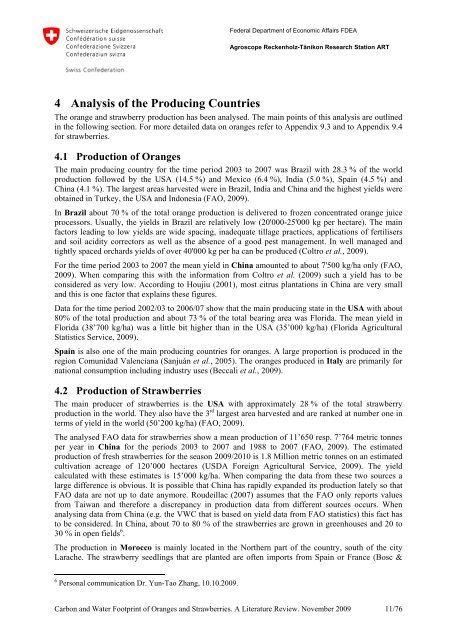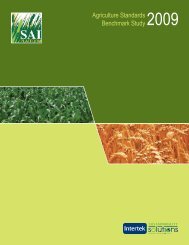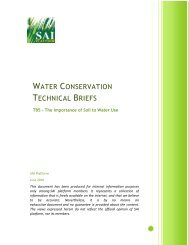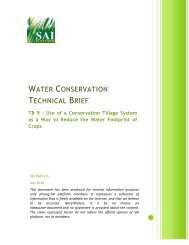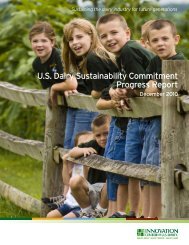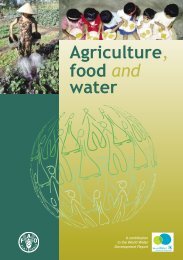Carbon & Water Footprint of Oranges and Strawberries - SAI Platform
Carbon & Water Footprint of Oranges and Strawberries - SAI Platform
Carbon & Water Footprint of Oranges and Strawberries - SAI Platform
You also want an ePaper? Increase the reach of your titles
YUMPU automatically turns print PDFs into web optimized ePapers that Google loves.
Federal Department <strong>of</strong> Economic Affairs FDEA<br />
Agroscope Reckenholz-Tänikon Research Station AR T<br />
4 Analysis <strong>of</strong> the Producing Countries<br />
The orange <strong>and</strong> strawberry production has been analysed. The main points <strong>of</strong> this analysis are outlined<br />
in the following section. For more detailed data on oranges refer to Appendix 9.3 <strong>and</strong> to Appendix 9.4<br />
for strawberries.<br />
4.1 Production <strong>of</strong> <strong>Oranges</strong><br />
The main producing country for the time period 2003 to 2007 was Brazil with 28.3 % <strong>of</strong> the world<br />
production followed by the USA (14.5 %) <strong>and</strong> Mexico (6.4 %), India (5.0 %), Spain (4.5 %) <strong>and</strong><br />
China (4.1 %). The largest areas harvested were in Brazil, India <strong>and</strong> China <strong>and</strong> the highest yields were<br />
obtained in Turkey, the USA <strong>and</strong> Indonesia (FAO, 2009).<br />
In Brazil about 70 % <strong>of</strong> the total orange production is delivered to frozen concentrated orange juice<br />
processors. Usually, the yields in Brazil are relatively low (20'000-25'000 kg per hectare). The main<br />
factors leading to low yields are wide spacing, inadequate tillage practices, applications <strong>of</strong> fertilisers<br />
<strong>and</strong> soil acidity correctors as well as the absence <strong>of</strong> a good pest management. In well managed <strong>and</strong><br />
tightly spaced orchards yields <strong>of</strong> over 40'000 kg per ha can be produced (Coltro et al., 2009).<br />
For the time period 2003 to 2007 the mean yield in China amounted to about 7'500 kg/ha only (FAO,<br />
2009). When comparing this with the information from Coltro et al. (2009) such a yield has to be<br />
considered as very low. According to Houjiu (2001), most citrus plantations in China are very small<br />
<strong>and</strong> this is one factor that explains these figures.<br />
Data for the time period 2002/03 to 2006/07 show that the main producing state in the USA with about<br />
80% <strong>of</strong> the total production <strong>and</strong> about 73 % <strong>of</strong> the total bearing area was Florida. The mean yield in<br />
Florida (38’700 kg/ha) was a little bit higher than in the USA (35’000 kg/ha) (Florida Agricultural<br />
Statistics Service, 2009).<br />
Spain is also one <strong>of</strong> the main producing countries for oranges. A large proportion is produced in the<br />
region Comunidad Valenciana (Sanjuán et al., 2005). The oranges produced in Italy are primarily for<br />
national consumption including industry uses (Beccali et al., 2009).<br />
4.2 Production <strong>of</strong> <strong>Strawberries</strong><br />
The main producer <strong>of</strong> strawberries is the USA with approximately 28 % <strong>of</strong> the total strawberry<br />
production in the world. They also have the 3 rd largest area harvested <strong>and</strong> are ranked at number one in<br />
terms <strong>of</strong> yield in the world (50’200 kg/ha) (FAO, 2009).<br />
The analysed FAO data for strawberries show a mean production <strong>of</strong> 11’650 resp. 7’764 metric tonnes<br />
per year in China for the periods 2003 to 2007 <strong>and</strong> 1988 to 2007 (FAO, 2009). The estimated<br />
production <strong>of</strong> fresh strawberries for the season 2009/2010 is 1.8 Million metric tonnes on an estimated<br />
cultivation acreage <strong>of</strong> 120’000 hectares (USDA Foreign Agricultural Service, 2009). The yield<br />
calculated with these estimates is 15’000 kg/ha. When comparing the data from these two sources a<br />
large difference is obvious. It is possible that China has rapidly exp<strong>and</strong>ed its production lately so that<br />
FAO data are not up to date anymore. Roudeillac (2007) assumes that the FAO only reports values<br />
from Taiwan <strong>and</strong> therefore a discrepancy in production data from different sources occurs. When<br />
analysing data from China (e.g. the VWC that is based on yield data from FAO statistics) this fact has<br />
to be considered. In China, about 70 to 80 % <strong>of</strong> the strawberries are grown in greenhouses <strong>and</strong> 20 to<br />
30 % in open fields 6 .<br />
The production in Morocco is mainly located in the Northern part <strong>of</strong> the country, south <strong>of</strong> the city<br />
Larache. The strawberry seedlings that are planted are <strong>of</strong>ten imports from Spain or France (Bosc &<br />
6 Personal communication Dr. Yun-Tao Zhang, 10.10.2009.<br />
<strong>Carbon</strong> <strong>and</strong> <strong>Water</strong> <strong>Footprint</strong> <strong>of</strong> <strong>Oranges</strong> <strong>and</strong> <strong>Strawberries</strong>. A Literature Review. November 2009 11/76


